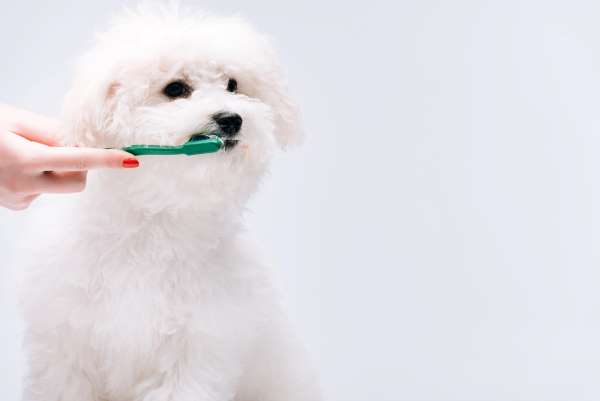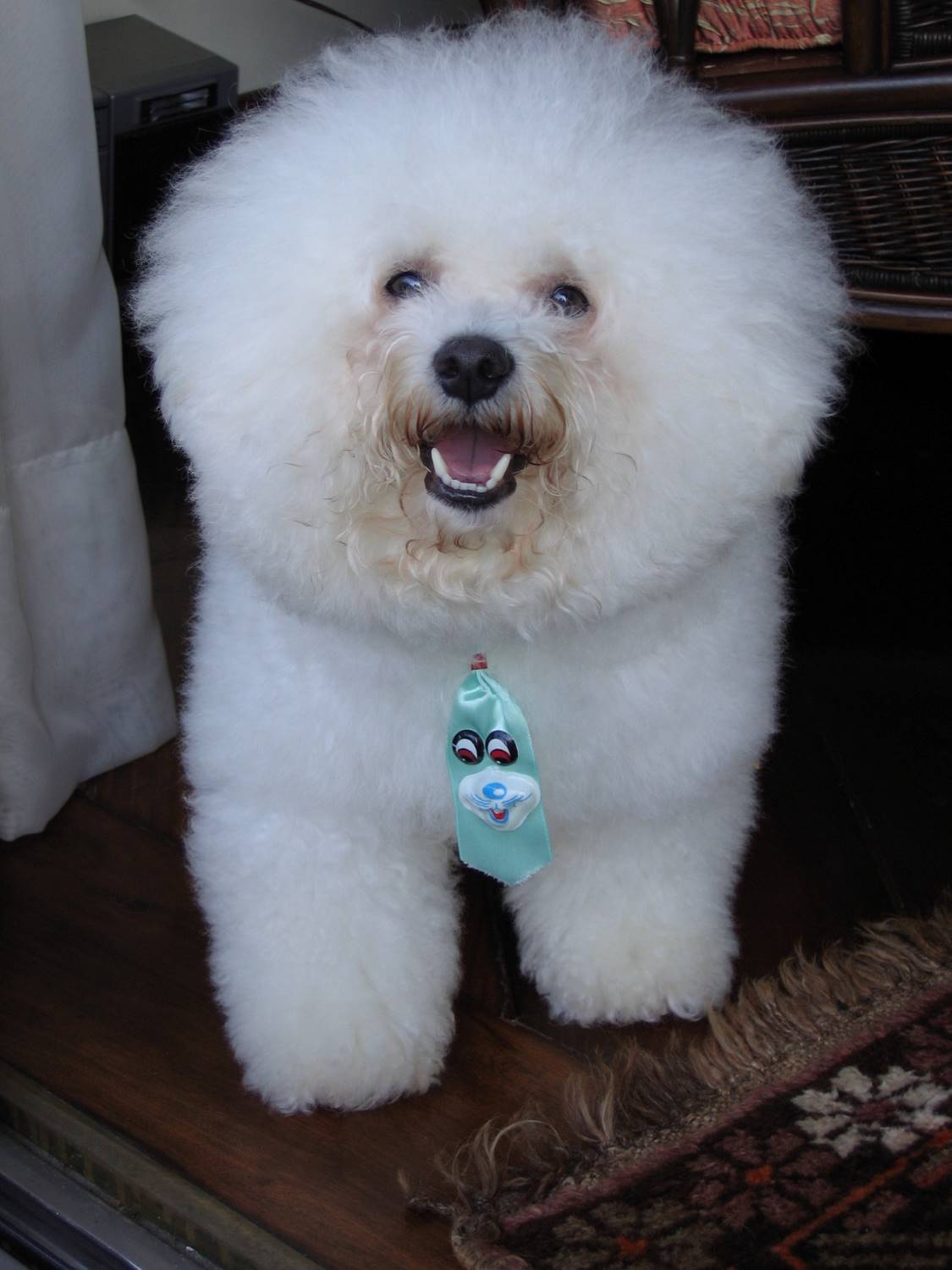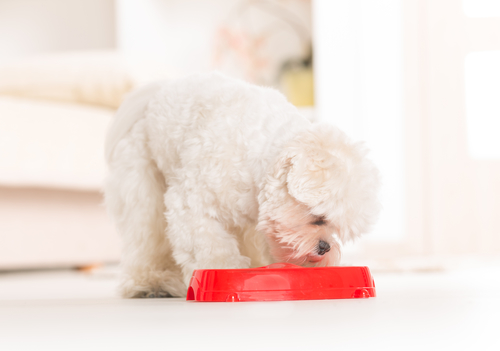If you’re like most pet parents, you just don’t know what normal dog gums look like. We pay attention to our dog’s teeth, but what about their gums?
Just like their wolf ancestors, dogs are carnivores and have teeth that were designed to tear and chew meat.
And, like human children, dogs have baby teeth and permanent teeth. Baby teeth appear when a dog is between 3 and 5 weeks old and they go through teething, just like children.
By the time your puppy reaches 7 months of age, he will have all of his permanent teeth.
As pet parents, we do pay lots of attention to our dogs’ teeth, and a bonus for taking care of your dog’s teeth is that he will also have healthy gums, as well.

This article will discuss:
- Normal Healthy Dog Gums
- The Color of your Dog’s Gums
- Common Gum Problems in Dogs
- Causes of Dog Gum Problems
Normal Healthy Dog Gums
So, if you look in your dog’s mouth, what do you see? If your Bichon has normal or healthy gums, you’ll see nice white teeth and pink gums that resemble shrimp after you’ve cooked them.
The gums will be nice and firm and they won’t be puffy or swollen.
You can test your dog’s gums to see if the texture is normal. Here’s how you do it. Press a finger into your dog’s gum line. Let go and see how long it takes to return to the original color. It should take no longer than 2 seconds.
If your dog passes this test, he has normal blood flow to his gums.
The Color of your Dog’s Gums
Sometimes your dog’s gums will be other colors. What does that mean?
Pale Pink or White Gums
If your dog’s gums are really pale, it could mean that your dog has anemia. In this case, the gums do not have a good blood supply or the blood itself is lacking in iron. You would also see this if your dog lost a lot of blood because of an injury or if she is bleeding internally.
A number of other diseases can also cause anemia, which would result in the pale pink or white color of a dog’s gums.
If your vet sees this color, she will need to do some testing, as most underlying causes are quite serious.
Blue Gums in your Dog’s Mouth
Blue could be a surprise, as you wouldn’t expect to see a blue color on your dog’s gums!
Of course, if your dog had an injury to his mouth, it could be black and blue from bruising. But there are other reasons that you might see blue.
If your dog’s gums are blue or purple, the color indicates that your dog’s blood doesn’t have enough oxygen. The medical term is cyanosis.
When a dog is having trouble breathing, he will have blue gums. If your dog is having trouble breathing, it’s important that you do not smoke around him. And, of course, he does need to see the vet.
Cyanosis indicates that your dog has a serious condition.
For example, cyanosis may be a symptom of:
- congestive heart failure
- pneumonia
- a blood clot in the lungs (pulmonary thromboembolism)
- other respiratory conditions.
Red Gums are not Normal Dog Gums
While pink is normal for a dog’s gums, red is not. Red or dark pink gums that are inflamed are not healthy.
If your dog becomes overheated, his gums will be bright red. We see this when a dog has a heat stroke, when he is panting rapidly, trying to cool his body down.
Bright red gums can also indicate that the gums are inflamed or infected. These are both periodontal problems and can make the gums tender and more likely to bleed.
Yellow Dog Gums are not Normal
Yet another unhealthy color for your dog’s gums is yellow. When you see this color, your dog may have Leptospirosis. This is a bacterial infection that affects the liver.
Leptospirosis can cause liver disease and jaundice. Jaundice is a yellowish color that affects the whites of the eyes and the skin. It is caused by levels of bilirubin in the body that are too high.
We sometimes see jaundice in newborn babies whose livers are still immature.
Bleeding Gums
Sometimes you will actually see blood in your dog’s mouth. When his gums are bleeding, a dog’s mouth is sensitive to touch.
Gingivitis, stomatitis and growths in your dog’s mouth can cause bleeding.
Common Gum Problems in Dogs
Changes in your Bichon Frise’s mouth do not always indicate a disease or illness. Your dog’s gums can also have some problems of their own.
Abnormal growths
These are known as oral tumors. Sometimes they are benign and just go away on their own.
On the other hand, at times, oral growths can be contagious or they can be cancerous. Tumors or growths in your dog’s mouth can cause pain and interfere with his eating and chewing.
An example of a contagious growth is Pappilomatosis. It is viral and produces pink, fleshy warts on a dog’s gums, in addition to other parts of his body. Sometimes you’ll see a single cluster of warts, or you might see hundreds of warts in a dog’s mouth.
This condition is most often seen in young dogs or puppies.
While Pappilomatosis is not as serious as other growths, it is easily spread from dog to dog.
When you are out and about do you ever see a communal water bowl that some well-meaning person set out for dogs in hot weather?
Consider carefully whether you want your dog to drink after other dogs. It’s better to carry your dog’s own travel bowl and water from home.
Bleeding Gums
Dogs who chew toys or bones roughly can injure their gums and cause them to bleed. Sharp pieces of bones or a chew toy can even get caught between the gums and teeth.
In addition, dogs sometimes injure their gums when running through briars in fields or woodlands.
Other than injuries, bleeding gums can be caused by:
- Oral cancer
- Kidney failure
- Ideopathic thrombocytopenic purpura or ITP – in this case the blood is not clotting normally
- Consumption of rat poison
How do you know when bleeding is serious? If bleeding lasts more than 10 minutes, then you probably need to take your dog to the vet to be checked.
Older Dogs
As dogs get older, their gums go through some changes. One of these is a tendency to have a bumpy or rough texture. This is especially true in large dog breeds like Labrador retrievers or St. Bernards.
Periodontal Disease in Dogs
This is the most common cause of gum disease in dogs.
Periodontal disease is most common in smaller breeds like Bichon Frises or miniature schnauzers, dogs that are less than 30 pounds. It’s one of the most common health issues for Bichons.
One of the reasons for this is that these dogs have large teeth in small mouths, and the teeth are crowded. This makes the growth of bacteria and the build-up of tartar quite common in small dogs.
Causes of Dog Gum Problems
While many of the gum issues above are caused by disease or illness, gingivitis or periodontal disease is caused by neglect of your dog’s teeth and mouth.
When you clean your dog’s teeth regularly and have the vet do a regular and more thorough cleaning regularly, you should be able to avoid serious gum issues for your dog.
As you can see, your dog’s gums signal changes in your dog’s health. Your veterinarian will look inside your dog’s mouth during visits, to see if there are any changes.
However, you should also check once in a while, to make sure that your dog still has healthy, normal dog gums.







Leave a Reply